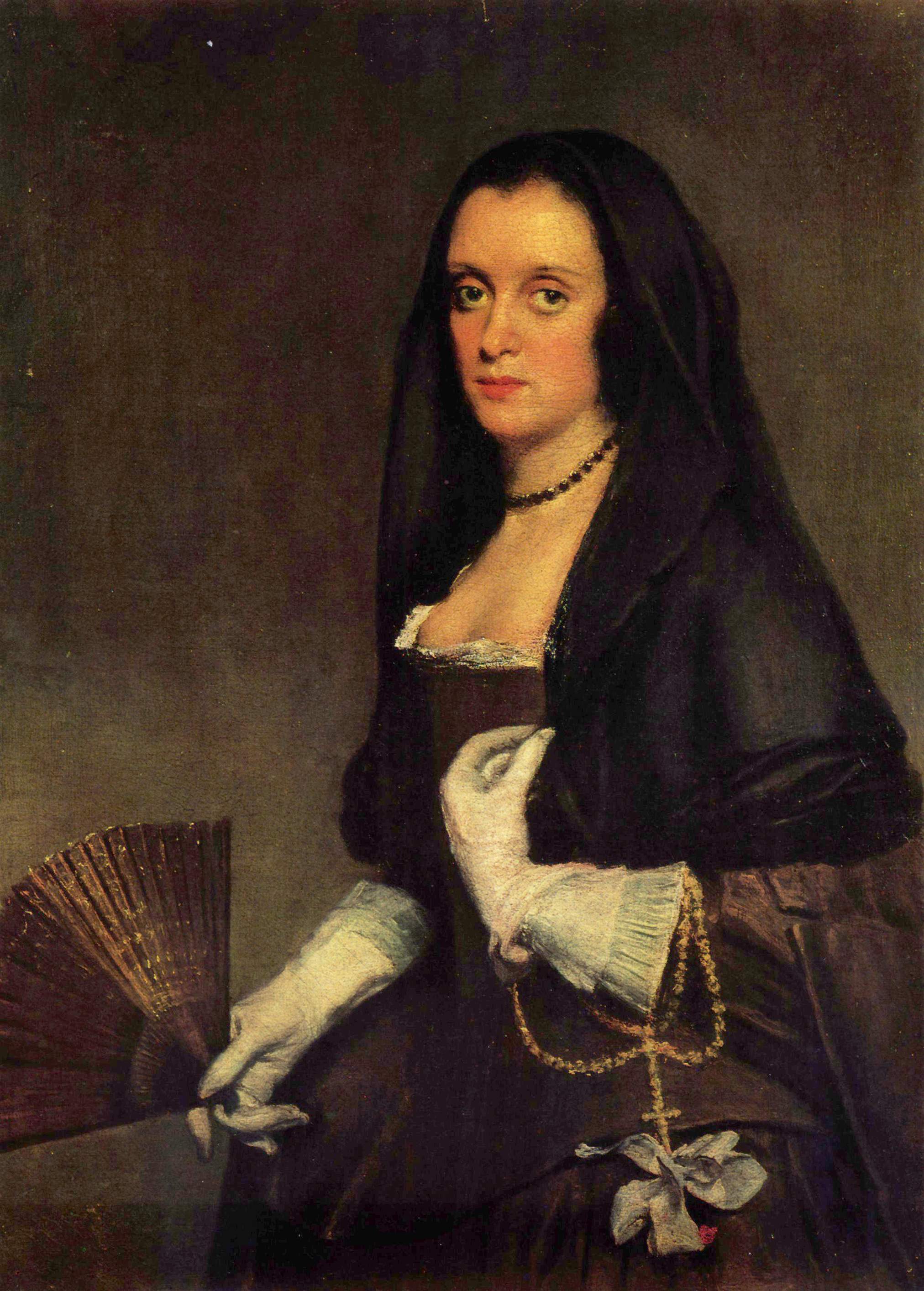- The Lady with a Fan (Velázquez)
Infobox Painting

painting_alignment = right
image_size = 250px
title = The Lady with a Fan
artist =Diego Velázquez
year = ca. 1638—1639
type = Oil on wood
height = 92,8
width = 68,5
height_inch =
width_inch =
city = London
museum =Wallace Collection "The Lady with a Fan" is an original
painting of a woman wearing a black lace veil on her head and a dark dress with a low-cut bodice, by the renownedcourt painter Diego Velázquez of Spain. On the basis of its place in Velázquez's stylistic development, the portrait is thought to have been painted between 1638 and 1639. [http://findarticles.com/p/articles/mi_m0422/is_1_86/ai_114244252 Veliz, Zahira Signs of identity in Lady with a Fan by Diego Velázquez: Costume and Likeness Reconsidered - Critical Essay, The Art Bulletin, March, 2004] , retrieved on: June 24, 2007] [The [http://www.wallacecollection.org/newsite/public/templates/tmpl_artwork.php?artworkid=713&openmenu=1_27_8 Wallace Collection website] is less certain, dating it to the second quarter of the 17th century.]The sitter
"The Lady with a Fan" is an enigmatic portrait. Although other Velázquez portraits are easily recognizable likenesses of the members of the Spanish royal family and high nobility, the in "Lady with a Fan" has not yet been convincingly identified; there is a lack of accurate documentary information about the portrait. The details of the costume suggest that the sitter for "The Lady with a Fan" could be
Marie de Rohan , theduchess ofChevreuse (1600-1679), because she was dressed according to French fashion of the late 1630s. There is, however, only one evidential reference indicating that Velázquez painted a Frenchwoman. This was a letter datedJanuary 16 1638 , which stated that he once portrayed theexile d duchess of Chevreuse, who was then living in Madrid under the protection of Philip IV. But some art experts argued that no resemblance could be discerned with other portraits of the duchess, and it was assumed that the costume of the woman in "The Lady with a Fan" revealed a Spanish "tapada ", which was a precursor to the "maja s" of the 18th century.Ownership
"The Lady with a Fan" was first registered in the collection of
Lucien Bonaparte in the early 19th century. It is believed that Bonaparte acquired it in Spain when he was there in 1801. But because there was no earlier record of the painting in any Spanish collection, it is also possible that he acquired it either inEngland or inItaly , where he spent most of the period of theNapoleonic Wars , or even in France, where Bonaparte had an encounter with the thenduke of Luynes , a direct descendant of the duchess of Chevreuse. By 1847 the painting was in the Hertford Collection, but it was later acquired bySir Richard Wallace for his own collection, where it remains."Lady in a Mantilla"
A variant of the portrait, the "Lady in a Mantilla", appeared in England before 1753, in an inventory taken at the death of
Lord Burlington . This version is on display atChatsworth . An entry from the 1689 inventory of themarquis ofCarpio 's collection suggested that the same Chatsworth painting was in the "quarta pieza" (fourth room) of Carpio's house, known as "El Jardin de San Joaquin", where it hung with twenty other portraits of men and women, ten religious paintings, and five mythological andsecular subjects.ee also
*Mother Jeronima de la Asuncion, a model for another painting by Velázquez.
References
;Specific;General
*cite journal|last=Zirpolo| first=Lilian|year=1994|title="Madre Jeronima de la Fuente" and "Lady with a Fan": Two Portraits by Velazquez Reexamined|journal=Woman's Art Journal|volume=15| issue=1| pages=16–21| doi=10.2307/1358490
Wikimedia Foundation. 2010.
